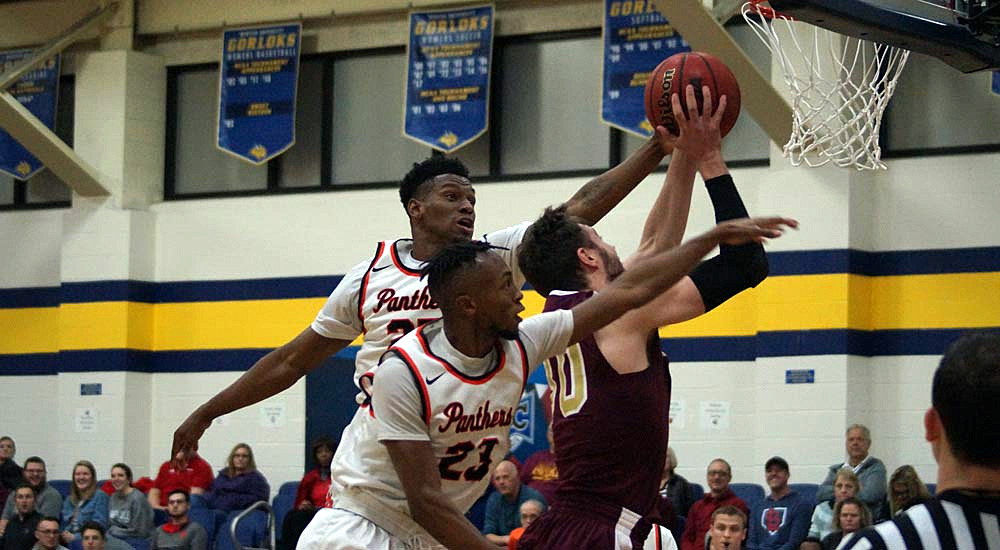
|
| Greenville athletics photo |
By Ryan Scott
D3hoops.com
Sportsmanship is a buzzword in athletics, one of those nebulous concepts everyone supports, but more as lip service. No one argues against good sportsmanship, but it rarely rivals winning in terms of importance. Look no further than team sportsmanship awards, which are often just a recognition of losing with dignity.
This summer, though, the St. Louis Intercollegiate Athletic Conference put some real teeth behind their drive for fair play, instituting a sportsmanship policy that costs offenders real playing time, some of it on the biggest stage.
In the fall of 2018, new SLIAC Commissioner Dick Kaiser noticed a troubling trend. “We had four [men’s soccer] teams within our conference ranked in the top ten in yellow cards in the nation. For a conference with sportsmanship as a core value, something seemed off with that statistic.”
Kaiser presented the numbers to conference athletic directors and as they were formulating a response, the Greenville men’s basketball team had a season uncharacteristically lacking in self-control at the worst possible time. The Panthers committed 21 technical fouls during the regular season, before combining with Eureka to commit eight more in the conference tournament semifinal.
“This had to be a policy that incorporated all team sports across the conference,” says Kaiser.
Basketball, baseball, softball, soccer, and volleyball (SLIAC-sponsored sports where individuals are penalized for unsportsmanlike conduct) now have team limits each season, the exceeding of which results in ineligibility for the post-season tournament. In basketball that number has been set at 14 technical fouls (or four ejections).
“It was embarrassing,” says Greenville head coach, George Barber, of his team’s technical foul barrage in 2018-19, “It was embarrassing. It was embarrassing to me. It is my responsibility as coach – not the players, mine – it’s 100% my responsibility and I failed miserably.”
Still, Barber says, the sportsmanship policy was enacted hastily and with too little preparation. “We need training, we need data, we need to be a little more careful and slow with something like this,” says Barber. “I’m all for personal responsibility. It’s very important to me. Penalize individual players – by all means – but don’t penalize a team because of individual performance.”
Barber was quick to say he does not want to stir the pot and is working hard to play within the rules, but it’s hard not to hear the hurt in his voice. He and Greenville can’t help but take the new policy personally.
Kaiser was adamant that the issue was originally driven by soccer, where penalties are undoubtedly more complicated. In basketball, technical fouls are almost never given in the course of play; they are typically offenses that occur after the whistle and thus, are far more preventable. Yellow cards in soccer come for all kinds of reasons, making the judgment of officials much weightier.
“We tried to set limits that are realistic for teams,” says Kaiser, who worked with a select group to arrive at the policy limits. Soccer teams are allowed nearly two yellow cards per game and basketball squads get one technical foul every 1.8 contests.
Are those the “right” numbers? No one knows, and that’s where Barber has some issues.
He says, “A technical foul is a very subjective thing. An official is exhausted at our games; they’re on edge. Emotions run high. I cannot statistically prove these technical fouls occur at a much greater rate, but I think it’s directly tied to our style of play.”
Greenville runs a version of the Grinnell “System” with hyper-fast tempo and tons of possessions. Obviously, overall, more fouls are called when more plays are run and run faster, there isn’t data to show how pace of play affects the rate of technical fouls. It’s very easy to dismiss the speed argument as an excuse, but without real numbers, it’s impossible to know for sure.
Barber also points out cultural differences. Greenville recruits more players from outside the Midwest than most SLIAC foes. “I believe Iowa Wesleyan has a high number of yellow cards, because they have a very high rate of international players on their team,” says Barber of the SLIAC-leading Tigers men’s soccer team, which was just disqualified from the conference tournament for receiving its 36th yellow card. “The international game is different from the American game. You’re saying everyone has to play the way we do in the Midwest. I would like more diversity training for those making these decisions.”
The sportsmanship policy was approved in a 29-1 vote by the SLIAC administrative council, comprised of athletic directors, senior woman administrators, and faculty athletic representatives from each school. It was unanimously adopted by the conference presidents.
“No one is against sportsmanship,” says Barber. “That’s just silly, but we need to do a better job with this.”
Yellow cards are down overall, in soccer, and we’ve yet to see how it impacts basketball, where Eureka’s men have also been skirting the edge of the limit for several seasons.
It should be noted that Greenville’s massive technical total last season was itself unusual. Even in the years since they’ve adopted “The System,” the Panthers have rarely come close to the 14 tech limit now imposed.
This policy also adopts suspensions for individual players. Upon receiving a seventh technical foul, individual players will be suspended one game, with an additional game suspension for every second technical thereafter. Barber fully supports this individual accountability.
Whether the policy has been implemented scientifically, fairly, or practically is yet to be determined. The conference can adjust the limits and punishments as they see fit. The effect, though, is undeniable.
“A coach called a foul in practice the other day. The kid gave not a terrible response, but a little bit of a response,” adds Barber, “One of the captains went nuts on him, saying, ‘we can’t do this,’ another captain backed him up, saying, “we can’t eliminate ourselves like this; we have to do better.’ The players are starting to own it, which is far more important than me saying it. We have to adjust and we will make no excuses.”
That’s good, because the SLIAC clearly isn’t going to stand for them anymore anyway.
Eastern Nazarene builds new recruiting bridge
Two years ago, this column explored the growing Native American presence on Division III basketball rosters, profiling three students blazing a trail from Rezball to the NCAA. One of those players, Seniesha Sekaquaptewa, now a junior at Eastern Nazarene opened a door that saw five other Native American ballers make the trek across the country to Quincy, Massachusetts, for college and basketball.
“When we recruit we try to turn every rock and find players wherever we can,” says ENC coach Sacha Santimano, “But Seniesha opened our eyes to a recruiting avenue we hadn’t really explored. She’s the ideal player you’d want in a program – she leads by example, she works her tail off, she does everything you ask her to do – we just wanted to find more players like her.”
While much is made of low college attendance rates among Native Americans and the lack of opportunities, both educational and economic associated with reservation life is fairly well known, Native Americans have among the fastest growing rates of college attendance and those graduates have a strong commitment to returning and strengthening those communities.
In my previous column, I wondered whether Division III basketball, which is known for creativity and determination in finding untapped resources, would embrace Native American players. The Eastern Nazarene women prove it’s certainly happened at one school.
The number of Division III women’s basketball players identifying as Native American has been pretty steady the last few years; if those numbers hold, nearly a third of them will be on the court for ENC this year. The Lions have been picked second, preseason, in the NECC. If that success continues, perhaps Santimano will have more competition on the recruiting trail.
Do you believe in karma?
If Justin Smith’s name sounds familiar, you may remember the Dubuque women’s basketball assistant coach for his quick thinking in averting a bus accident two seasons ago. Smith took control and stopped the team bus after the driver passed out on the way home from a tournament in Tennessee.
That story garnered him national attention and some measure of fame. Smith and his wife, Casey, had a similar, less frightening experience this summer when they won more than $700,000 on the Fox game show, Spin the Wheel.
“I could never have imagined all the media attention,” says Smith, “Between the bus accident and then the game show a year and a half later, it’s been a bit of a whirlwind.”
As a local high school coach for a decade before joining the Spartans, Smith was already pretty well known in Dubuque, a community of about 60,000, but it’s Casey who deserves most of the credit for this latest achievement. She had to choose, in each round of the game, whether they took the money on offer or risked it on another question without any communication with her husband.
“I’m a bit of an introvert,” says Smith, “She pushed me to do it and she had all the pressure backstage. I wouldn’t have stuck it out so long.”
With their first child under a year old, the money will come in handy for the Smiths, who both coach basketball; they’ll save some for the future, but plan to give much of it away. “It’s the perfect amount,” says Justin, “There’s enough to do lots of good things, but not enough to change our lives.”
Sad passing
In other, much sadder American Rivers Conference news, I want to recognize the life and impact of Canyon Hopkins, a member of the Buena Vista men’s basketball team who died of cancer earlier this fall. Known as “Moose,” Hopkins had been a starter for the Beavers as a sophomore, before being diagnosed with a soft tissue sarcoma in the fall of 2018.
I’ve been overwhelmed reading the remembrances of family and friends who were touched by a big guy with a big heart. He was an inspiration to the campus community and a wonderful example of what a Division III student athlete should be. Our sympathy goes out to those who loved Canyon during this time of mourning.
I also hope his story is a positive reminder to all of us, as we enter the competitive part of the season, that basketball is about much more than wins and losses.
